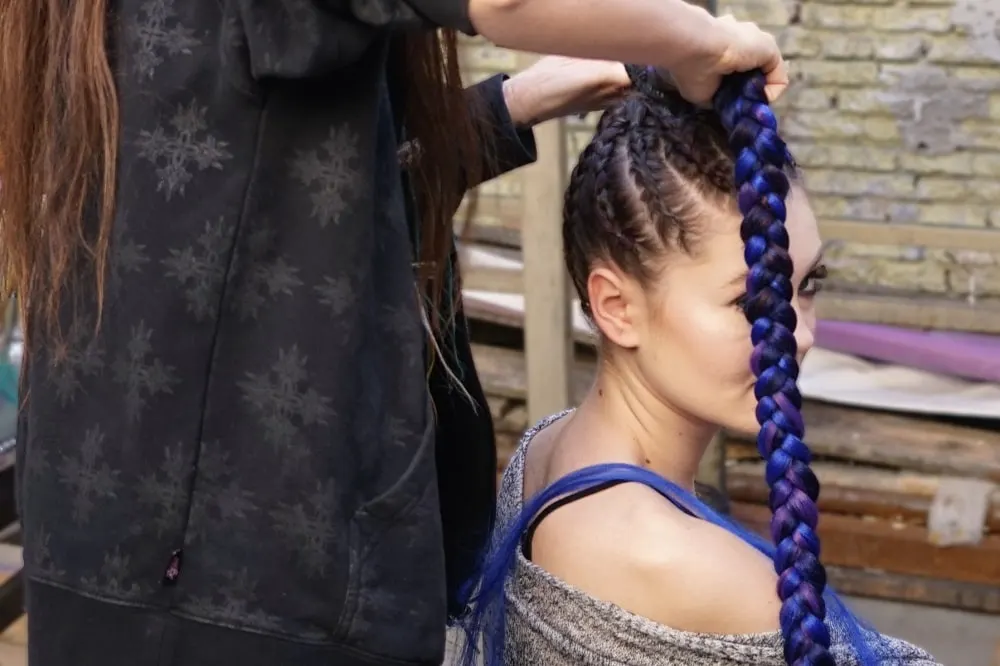Many times I heard people asking for their cornrows to last as long as possible, but the only thing I can do is recommend they choose a narrowed pattern and maintain the cornrows properly.
Even so, cornrows aren’t made to last for too long, as they are unmovable and continuously attached to the scalp, so there is not much access for washing like there is for single braids.
Still, they need to be cleaned if you want to keep them for more than a week. And your scalp needs to be washed and moisturized if you don’t want to die scratching yourself and have your cornrows full of flecks.
How to Wash Your Cornrows

Get into the shower, turn the water on and wet them all over. The shampoo (preferably a sulfate-free, organic one) can be diluted with water, but it isn’t mandatory.
It makes it easier to distribute it and rinse it off. You can mix it in your palms but if it is possible, use an applicator with a nozzle to mix and distribute it on your scalp, between the lines of your cornrows.
Apply the shampoo everywhere between the lines of your cornrows and gently massage your scalp and the length of your braids with the pads of your fingertips. Don’t rub it too vigorously so it wouldn’t frizz.
The moves should be in the direction that has been braided and from the headline toward the neck, not backward (except when there is an updo pattern).
Go back under the shower and rinse off the shampoo, then apply again and repeat the process.
Now the second time you rinse off the shampoo, make sure you get everything out and there is no shampoo left.
Optional, for textured or dry hair only, use a conditioner. Gently apply it on your scalp and let it there for +/- 10 minutes. Rinse it out with plenty of warm water.
Use a soft microfiber or a soft cotton towel to pat, squeeze and dry your braids.
After washing your hair it is recommended to use a leave-in conditioner or oils that help your scalp stay hydrated and moisturized.
How to Clean Your Cornrows without Washing Them
If you want to clean your cornrows but not get under the shower, you can use a braid care kit or a dry shampoo and conditioner/light oils.
However, if it is still itchy after, you may need a deeper cleanse.
How to Prevent Dandruff and Itchiness in Cornrows?
Keep your scalp moisturized and hydrated. Use a moisturizing spray or light oils suitable for your hair type and clean your scalp and your cornrows as often as you need.
How to Prevent and Fix Frizzy and Messy Braids?

In order to prevent frizz and messy cornrows, you need to reduce friction as much as possible.
The best investment you can make is to get satin or silk bedding. You can also wrap a satin scarf or a satin bonnet on your head when going to sleep if you can’t or don’t want to use silky sheets, but those are also good for your unbraided hair, as it prevents breakages, thrill and tangling. It also helps you prevent the apparition of wrinkles.
Try not to wear tight shirts like turtlenecks, as well as rough fabrics like wool, especially if it is on your head (like caps and hats), but even just the touch might be damaging.
Don’t scratch your head, wash it.
If you want to use a hair dryer, wrap a satin scarf over your head after moisturizing and only use it after, with the scarf on, so the hairs will lay down and stay flat.
You can also use this method to lay down your frizzy and baby hair after each moisturizing session. Another way to calm down your frizz is to use a mousse and wrap a satin scarf on your hair after.
Use a brush (mascara or toothbrush would work) for arranging your headline baby hairs back on the head or draw nice curves on your forehead.
How to Prevent Hair from Breakage and Harm When Getting Cornrows?

First of all, you should avoid any painful hairdos. If your hair hurts when braided and even after, it isn’t normal. You don’t need lifting surgery when getting cornrows, and your hair is not a surgical thread.
Don’t ever take a painkiller pill if a braider recommends you to use it so you won’t feel the pain anymore because such a hairstyle is dangerous for your hair, it can cause sores, hair loss, and even traction alopecia.
Tell the braider if it hurts you and ask to make it less tight. If they can’t, just go away. If you don’t do this, you’ll have to unbraid it urgently after it’s done.
Don’t look back after the money and the time you lost, the hair you’re going to lose if you wait until the pain goes away will probably not come back.
Moisturize, nourish, clean and hydrate your scalp when braided.
Take breaks between one and another braiding session and don’t keep them for too long.
And the last, but not the least important thing, be very patient with the removal process. Take off your braids carefully and detangle your hair with a lot of patience and use conditioning products if you need them.
If you don’t use them when you unbraid your hair, you need to use them anyway before shampooing it. Wash your hair very gently the first time after having your hair braided.
And in the end, don’t forget to love your hair!
FAQs on Cornrow Maintenance
Depending on your hair type, pattern choice, and the way you take care of them, between 2 and 6 weeks.
Wash them and use leave-in cleaning products as often as you need, normally one time per week you would need a deep cleaning process.
Yes, you can shower with cornrows and even wash them with shampoo and plenty of water.
Wrap a satin scarf/bonnet on your head or use silky bedding. You can also moisturize your scalp before going to sleep. Bonnets or scarves help you get the most of the products used into your hair and scalp because they would not evaporate and they also help your hair stay flat.
Related Topics
